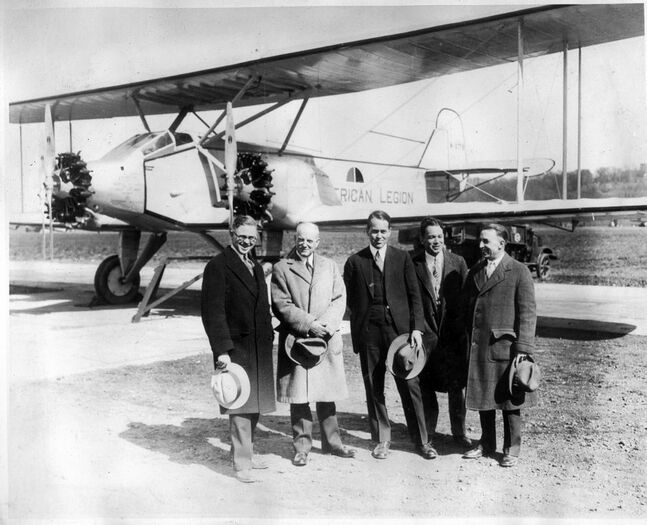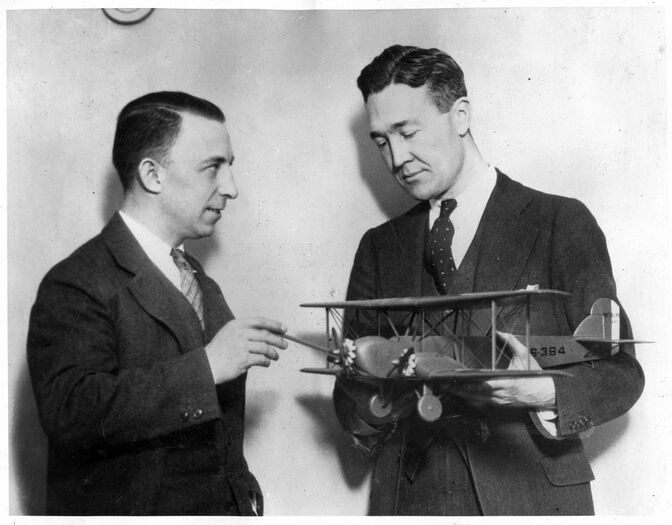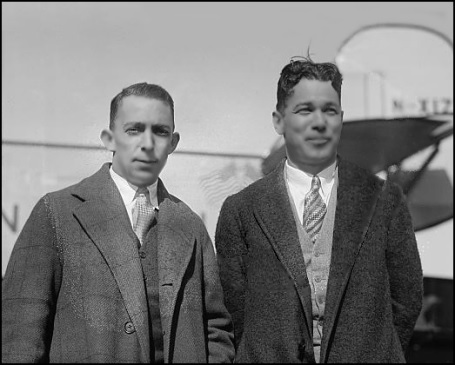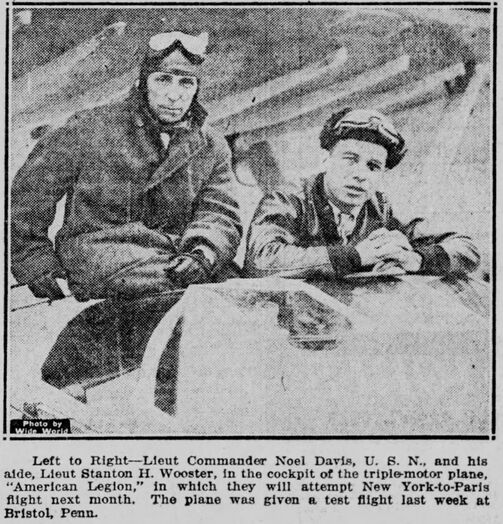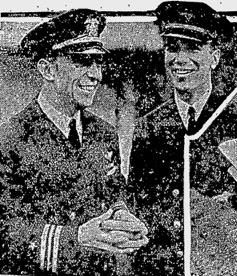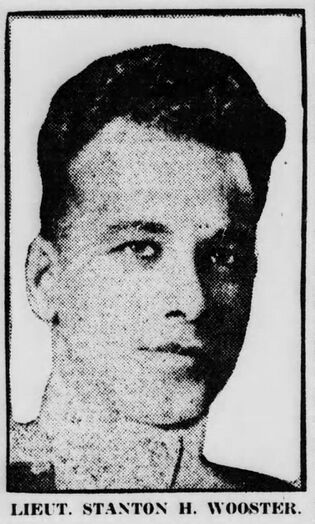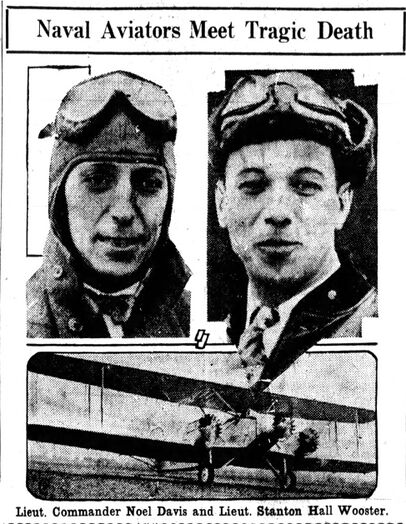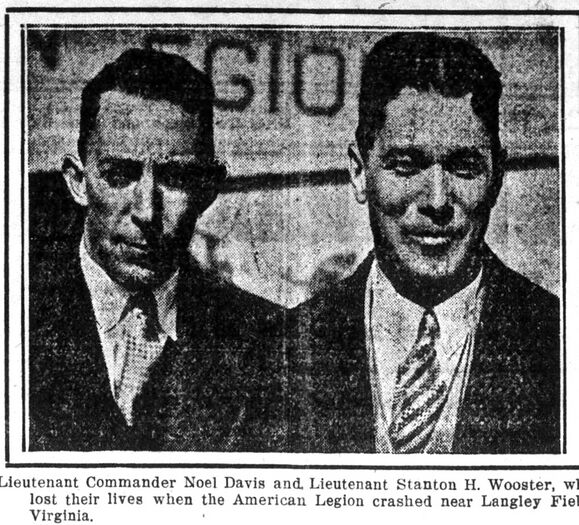STANTON H. WOOSTER, LT, USN
Stanton Wooster '17
Lucky Bag
From the 1917 Lucky Bag:
STANTON HALL WOOSTER
New Haven, Connecticut
"Bob"
NOW come to a most unique character, a man full of life, full of enthusiasm, and, above all, full of an inherent desire to seize every opportunity to do a friend a good turn. The most remarkable feature about him is that, although he is always anxious to boost a friend, he is just as anxious to do it secretly and without any show or desire for praise. It is unfortunate for the medical profession that they did not get Bob, for he most certainly possesses the gift of making a blue fellow happy and contented.
Bob is a fellow easily moved, but good advice is to use a little discretion which way you move him. Just say to him, "No, I won't, Bobby," or ask him the latest method of washing buckskin gloves, and his old physiog will display the most attractive, reddish tinge, a substitute for which can only be sought in the modest cheeks of the fairer sex. Accuse him of cowardice and he will show you by a process of "elimination" that your accusations are not well founded. Mars, the God of War, in all his horrible attire and accoutrements of battle cannot frighten him.
Bob would rather coal a battleship alone than study Dago. And by this I do not mean that he is wooden by any means. Just look at any of the past three Registers to assure yourself that such is not the case. Bob's savviness does not consist in remembering a mass of formulae; he simply dopes out everything.
To say the least, make Bob Wooster's friendship and you have added to your list a person whose high standards you are sure to copy. There is nothing mediocre in his entire make-up. His everlasting maxim is to be by and to do for a friend just ten times what he expects that friend to do for him.
Buzzard; Choir (4, 3); Glee Club (4, 3, 2); Masqueraders (4, 3).
The Class of 1917 was the first wartime-accelerated class, graduating on March 29, 1917.
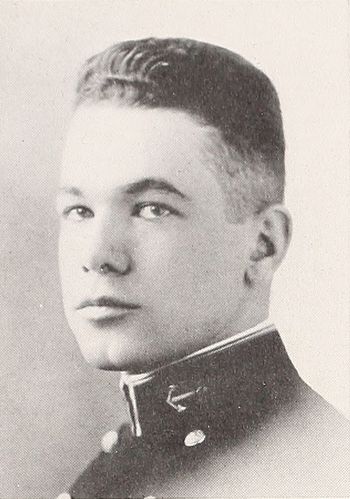
STANTON HALL WOOSTER
New Haven, Connecticut
"Bob"
NOW come to a most unique character, a man full of life, full of enthusiasm, and, above all, full of an inherent desire to seize every opportunity to do a friend a good turn. The most remarkable feature about him is that, although he is always anxious to boost a friend, he is just as anxious to do it secretly and without any show or desire for praise. It is unfortunate for the medical profession that they did not get Bob, for he most certainly possesses the gift of making a blue fellow happy and contented.
Bob is a fellow easily moved, but good advice is to use a little discretion which way you move him. Just say to him, "No, I won't, Bobby," or ask him the latest method of washing buckskin gloves, and his old physiog will display the most attractive, reddish tinge, a substitute for which can only be sought in the modest cheeks of the fairer sex. Accuse him of cowardice and he will show you by a process of "elimination" that your accusations are not well founded. Mars, the God of War, in all his horrible attire and accoutrements of battle cannot frighten him.
Bob would rather coal a battleship alone than study Dago. And by this I do not mean that he is wooden by any means. Just look at any of the past three Registers to assure yourself that such is not the case. Bob's savviness does not consist in remembering a mass of formulae; he simply dopes out everything.
To say the least, make Bob Wooster's friendship and you have added to your list a person whose high standards you are sure to copy. There is nothing mediocre in his entire make-up. His everlasting maxim is to be by and to do for a friend just ten times what he expects that friend to do for him.
Buzzard; Choir (4, 3); Glee Club (4, 3, 2); Masqueraders (4, 3).
The Class of 1917 was the first wartime-accelerated class, graduating on March 29, 1917.
Loss
Stanton was lost on April 26, 1927 when the plane he was piloting, American Legion crashed in Virginia. He and the pilot, Noel Davis '17, were on their final test flight before attempting to cross the Atlantic Ocean for the first time. Charles Lindbergh accomplished the feat several weeks later.
Other Information
From Find A Grave:
Lieutenant Stanton Hall Wooster and Lieutenant Commander Noel Davis were United States Navy airmen who made an attempt to fly the Atlantic Ocean from New York-to-Paris in the spring of 1927. The men were trying to win the $25,000 dollar Orteig Prize offered by New York hotel owner Raymond Orteig for the first nonstop flight between New York and Paris. Wooster and Davis flew a Keystone Pathfinder plane called American Legion (N-X179). While testing with a heavy load of gas on April 26, 1927 the Pathfinder lost altitude and crashed on its nose in Virginia killing both men. Charles Lindbergh won the prize for his successful flight in the Spirit of St. Louis on May 20-12, 1927.
From researcher Kathy Franz:
Stanton was named second alternate to the Naval Academy by Senator McLean in June, 1911.
Stanton graduated from New Haven high school in 1913. He went one year to Yale but then was appointed to the Naval Academy. At Yale, he was a second tenor in the Freshmen’s glee club.
During World War I, he served on the battleship Nebraska in the convoy service. After the war, he was assigned to the Naval Bureau of Aeronautics.
From March to June, 1921, Stanton was on a special mission to the Mediterranean. In May, 1922, he was ordered to the Massachusetts Institute of Technology.
Stanton married Marjorie/Margaret Louise Slade of Surrey, England, on June 18, 1924, in Norfolk. She was granted a divorce on October 31, 1925, in Arlington, Virginia.
From The Evening Star, formerly The Sunday Star, June 27, 1926:
Aviator, Racing With Dawn Rushes Star to Boosters
Lieut. Stanton H. Wooster U. S. N., Carries Papers to D. C. Party.
Hops Off in Plane at 4:30 A.M. on 120-Mile Trip to Hampton Roads.
Flying with the dawn, Lieut. Stanton H. Wooster, Navy airman, this morning planned to race a special edition of The Sunday Star to the members of the Merchants and Manufacturers’ Association lying at Hampton Roads as they prepared for the last lap of the booster trip.
The naval officer was to jump off promptly at 4:30 o’clock from the station at Anacostia in a powerful SC-2, capable of covering the 120-mile trip at a speed of more than a mile a minute. No time was to be lost in rushing the papers fresh from the rumbling presses to the plane, which waited in readiness for the hop.
A land plane was to be used for the flight, and Lieut. Wooster’s schedule called for him to land inside of Willoughby Spit, at the Norfolk naval base, where a boat, furnished through courtesy of the Navy, was waiting to convey The Star to the Southland, on which the boosters are making their trip.
From the June 28 newspaper:
The early dawn flight, which took but an hour and 25 minutes, developed into a test of the flying ability of Lieut. Wooster when the engine threatened to go out of commission. He skillfully managed the ship, however, and effected a perfect landing at the naval air station at Hampton Roads, Va. From there a navy launch took the papers across the bay to the Old Point wharf, where the Southland had docked.
Lieut. Wooster took off from the naval station here at 5 o’clock yesterday morning and headed into a stiff breeze from the southeast. He traveled at speeds ranging from 80 to 100 miles an hour, attaining a height of 5,000 feet. Near Mount Vernon the engine sputtered and coughed and threatened to stop while Lieut. Wooster worked to adjust it. Later it struck into a rhythmic tune and the plane picked up speed.
Stanton was survived by his uncle Col. George E. Hall, Connecticut State Senator, and his aunt, Miss Agnes Hall, his mother’s sister who was a teacher in the New Haven High school.
His father was Rollin, a lawyer who became a Baptist minister. In 1910, Stanton lived with his mother Mary and his aunt Agnes in New Haven.
After his historic trans-Atlantic flight on May 21, 1927, Col. Charles A. Lindbergh visited the Walter Reed Hospital on June 12. His mother was with him. Miss Sally Finney, who had been engaged to Stanton only a few days before he was killed, approached Mrs. Lindbergh and said, “I want to congratulate you on your son’s achievement. I think it was splendid. And I am sure that Mrs. Davis would wish to join me in saying so.” (per The Boston Herald, June 13, 1927.)
Per the Cleveland Plain Dealer, May 14, 1927:
Indianapolis, Ind., May 13. – (AP) – Two resolutions, one expressing hope for the discovery of Captains Nungesser and Coli, missing French aviators, and the other regret over the deaths of Lieutenant Commander Noel Davis and Lieut. Stanton H. Wooster in their trial flight preceding a trans-Atlantic attempt, were adopted today by the executive committee of the American Legion.
“We honor the heroic attempt of these brave citizens of our sister country, France, and express for them our sincere admiration,” the Nungesser-Coli resolution said.
“We offer to the bereaved families of these heroic airmen sincere sympathy of the American Legion and we record in the annals of the legion history the gallant effort of these two aviators to win for America a great laurel,” the council said concerning Davis and Wooster.
From the Richmond Times-Dispatch, April 27, 1927: Speaking over radio station WOR in Newark, New Jersey, Lieutenant Commander Richard E. Byrd characterized Davis as “the most able and brilliant lieutenant-commander in the naval aviation” and Wooster as “the most able of lieutenants.”
Commander Byrd concluded his eulogy with the glowing tribute: “They have gone West – and we may be sure that they went unafraid. Their loss is inestimable but their brave spirit will accelerate the aviation of our country.”
He is buried in Arlington National Cemetery.
Those Willing to Dare
From Naval Aviation News in March-April 1999, via Naval History and Heritage Command:
Monday, 25 April 1927, Langley Field, Va.: Several reporters gathered at Langley Field this morning are questioning two Navy pilots about their preparations for the first nonstop air crossing of the Atlantic Ocean, from New York to Paris. But the winds are unsatisfactory for today's test flight, allowing the two Naval Aviators a few minutes to answer some questions. Commander Noel Davis and Lieutenant Stanton Wooster are standing in front of their aircraft, christened American Legion. Cdr. Davis, the pilot, gives an update on the project.
"We are almost ready to get away now, but there is no hurry about the trip. We want to have everything in our favor and I think the May full moon will give us favorable weather."
He continues with a description of the American Legion. "I have never piloted a better plane. Some of us had feared that when the machine was loaded to capacity, as she will be when we start on our long flight, a large field would be necessary for her to get up, [but] the machine rises in less space than is required for some smaller planes. It is the best mechanical bird I have ever seen, and I believe we will make the flight to Paris with few difficulties."
A reporter directs a question to Cdr. Davis: "Do you really believe these big flying machines, manufactured in this country, are capable ..."
Davis interrupts and looks directly at the reporter. "A few years ago we held all the aviation records. We have lost nearly all of them. We make as good planes and motors as any country in the world, and we have as good pilots. I want to see some prestige in the air return to our country."
Later, another reporter asks, "Are you ready?"
No two aviators are better prepared.
A graduate of the U.S. Naval Academy, Noel Davis is described by his classmates as a "sturdy little giant who can do anything, exceptionally well." Davis went to NAS Pensacola, Fla., in 1920, and became a Naval Aviator in August 1921. He later headed the Naval Reserve Flying Headquarters in Washington, D.C. In his spare time he solved a persistent aircraft navigation problem by creating the Davis aircraft sextant.The first one to be manufactured is to be used on his nonstop flight across the Atlantic. The Navy has ordered several of them, confident in Davis' assessment of its functionality.
In flying, having total confidence in your copilot is paramount. Lt. Stanton Wooster meets Davis' high standards; some say he's the top Naval Aviator at flying large, heavy airplanes. Wooster actually pilots the airplane more than Davis, who is frequently busy with instrumentation data and calculations.
Wooster attended Yale University and graduated from the Naval Academy in 1917. He was later assigned to NAS Pensacola for flight training, qualifying as a Naval Aviator in June 1920. Since his assignment to the Bureau of Aeronautics in September 1924, he has assisted Davis with planning the Atlantic crossing. Wooster has some ideas he believes will improve the operation of flying machines. For example, he supports the use of metal propellers, with which the American Legion is equipped. Many experts continue to doubt the capabilities of metal propellers versus the proven wooden designs.
Both pilots supervised the construction of the airplane, a Keystone Pathfinder, at Bristol, Penn., and have made all of the test flights together. The Pathfinder at Langley Field has been modified with several tanks totaling 1,500 gallons, five times the usual capacity. The fueled airplane weighs in at 16,000 pounds. Some say it's a flying fuel tank. Today, the airplane will fly at its maximum weight for the first time.
The dimensions of the aircraft are also impressive: 45 feet long, with a wing span of 67 feet. The American Legion is equipped with three Wright J-5 Whirlwind engines, rated at 220 horsepower each one in the nose and one on the upper surface of each lower wing. If one of the engines fails during flight, the airplane will be able to continue flying.
Tuesday, 26 April: Everything is "go." When the ground crew reports to Langley Field, they find the three large propellers turning. Wooster is at the controls. Everything is operating perfectly, and the morning weather is ideal for flying.
Davis meets with ground crew members for some last-minute instructions. He directs the mechanics to go down the field, spaced far apart so they can measure the take off. This is it: the final test flight! After returning to Langley Field, the next flight of the American Legion will be to New York for final preparations and then the prize the first nonstop air crossing of the Atlantic Ocean.
A few minutes later, Davis joins Wooster in the cockpit. With the pre-flight checks completed, Davis orders the brakes to be released. The American Legion begins to tremble as Wooster takes the airplane to the end of the runway, where he idles the engines and prepares for takeoff.
As the plane begins to move down the runway, the tail begins to lift as the speed increases, but the wheels are still on the ground. A few individuals have pocket watches and are timing the takeoff. Ten ... 20... 30 seconds ... the airplane is not lifting off. And, then, finally — wheels off! The aircraft has required a quarter mile of runway to become airborne, and it just misses touching a thicket of pine trees at the end of the runway by only a few feet. From the dirigible hangar the ground crew and officers watch as Wooster keeps the airplane close to the ground. Moments later, the American Legion is over the waters of Back River on the northern boundary of Langley Field.
Suddenly, there's a problem. Both are looking at the instrumentation panel, engines and wing surfaces. Wooster adjusts the controls and turns the American Legion into the northwest wind. This maneuver results in a limited increase in altitude, which is around 50 feet - far less than normal at this point in flight. On the present course, the American Legion won't be able to clear the approaching tree line. Davis decides to circle back toward Langley Field, but as the plane banks right it loses the benefit of the head wind. Almost immediately, the airplane side slips and decreases in altitude. It's obvious that the flight will have to be aborted. Working together, Davis and Wooster bring the airplane under control for an emergency landing in the marshes that border Back River.
Within moments, the aircraft passes over a small section of shore line. The right wheel touches first, then the tail and the fuselage hit. For about 125 feet the plane skids across the marshes, kicking up mud and water. Major damage occurs on impact, especially to the landing gear, engine propellers and port-side wing. The American Legion continues to skid across the marshes until it hits a large pond. When it reaches the other side, the airplane crashes nose down and the center motor is torn from the mounting.
Local Virginia watermen, work ing their fish nets in Back River, witness the crash and stop their work to rush to the aircraft. The area contains leaking aviation fuel, and the engines are smoldering. Disregarding the danger, they know they must provide assistance if there is any chance of saving the pilots.
The watermen retrieve an anchor rope from a nearby boat. Several climb onto the airplane, securing one end of the rope to the tail section. Pulling on the rope in an effort to right the airplane, the rope snaps.
A stronger rope is tried, but it also breaks. They attempt to reach the pilots by digging through the mud, but are unsuccessful. The two aviators are dead.
The bodies of Cdr. Davis and Lt. Wooster are removed from the aircraft by midmorning. Both pilots were found buckled in their seats; they had died from injuries received during the crash. Their bodies are transported to the Langley Field hospital.
Word quickly spreads throughout the world of the crash and the untimely deaths of the pilots. Polar explorer Commander Richard E. Byrd, who is also preparing to be the first to fly nonstop across the Atlantic, issues a statement later in the day. "The deaths of Davis and Wooster came as a distinct shock. We were rooting for each other. I hoped that both would make Paris for the advancement of science. Only several days ago I wrote [Davis] offering what assistance he cared to ask of me, and his last message to me before taking off was to offer some good advice. It was this type of splendid American that aviation has lost. It was this type that makes one feel proud to strive for the same goal. Both Davis and Wooster have given their lives to the science of aviation. They were my old friends. Each was a brilliant, courageous air pioneer. Their loss to aviation is irreparable."
Both aviators are later buried with full military honors, Cdr. Davis in Pensacola and Lt. Wooster in Arlington Cemetery, D.C.
Although others will soon succeed where they have failed, Davis and Wooster nonetheless leave their mark on the early years of Naval Aviation. For future generations, they will represent the spirit of all those pioneering pilots who dared lay their lives on the line to reach for new heights in Naval Aviation.
American Legion Flies New York To Paris In 1927
From American Legion Department of California, by Kevin Burns on February 28, 2022:
In 1927, the race for the Orteig prize became one of the greatest sporting events in all history. People around the world followed every tidbit of news that was reported on it. Often if there was no news, reporters simply made it up to sell newspapers. It was part of the culture of the times. Raymond Orteig, a New York hotel owner from Paris, set the goal of flying non-stop from New York to Paris, or from Paris to New York, with a prize of $25,000. From 1919 to 1925, no one attempted to win this prize. The technical advancements to make it possible just were not there.
Although a number of fliers announced their intent to compete in the race, only two filed applications in 1927 for the New York to Paris contest; Charles Lindbergh and Noel Davis. Others like Richard Byrd and Clarence Chamberlin announced that they would compete and comply with the race rules, but were not interested in the prize money and did not want to be restricted by the requirement of having to register for the prize sixty days before the flight.
Lt. Cdr. Noel Davis was Commander of the Naval Air Reserve under Admiral Moffett. He had gone to the Naval Academy with his copilot, Lt. Stanton “Bob” Wooster, whom was head of the Navy’s Propeller Research Center at Langley Field in southern Virginia. Both of them were excellent aeronautical engineers and as members of the American Legion, they looked to the Legion for support. Davis had two huge tasks ahead of him now; finding a suitable airplane to make the transatlantic trip and to find sponsors to fund the expedition.
He decided upon the Huff-Daland LB-3; an Army heavy bomber plane that had a solid reputation. It was a two-engine biplane with a large machine-gun emplacement in the nose. Davis planed on taking out the machine-gun emplacement and putting in a third Wright Whirlwind engine. The reliable air-cooled radial Whirlwind engine was the technology that finally made the attempt possible with its thrust to weight ratio.
Davis still faced some formidable obstacles; he needed to raise cash quickly, get his publicity arrangements made, and to come up with a name for the airplane. Being a well known veteran of World War I, having set and removed the North Sea Barrage under Admiral Strauss, and being a vocal proponent of military aviation, he turned to the American Legion organization. In 1927 the national convention was to be held back where it originated in Paris, France, on the tenth anniversary of the US entering the Great War. Who better to sponsor the flight of two war veterans who were still active in military aviation?
There was immediate support from the Aeronautics Commission, and at the urging of the chief lobbyist for the American Legion, John Thomas Taylor, Davis wrote to Bowman Elder (who was the Chairman of the American Legion convention to be held in France) and to Howard Savage (the National Commander of the American Legion), whereby Davis conveyed his plans in detail. These letters were accompanied by letters from Porter Adams (President of the National Aeronautic Association, and Chairman of the Aeronautic Committee for the American Legion’s Department of Massachusetts) and Rear Admiral William Moffett (Chief of the Navy’s Bureau of Aeronautics); both urging the American Legion to lend their support to the effort.
Elder, at the national headquarters of the Legion in Indianapolis, promised to bring it before the National Executive Committee (NEC) of the American Legion and to promote the Legion’s support of the effort, and asked for more details. There was a ground-swell of support from the average Legionnaire to many officers in the state and national organizations of the American Legion, but funding such an expedition was breaking new ground and many within the organization were hinting that the National Executive Committee would be cautious in their decision.
They were correct. After the National Commander had made national news at the christening of the airplane as it was named the “American Legion;” the NEC ruled that because they were going for a cash prize, it was a commercial venture that the American Legion could not support. However, they softened the ruling by allowing the airplane to be named “‘The American Legion,’ providing it could be accomplished without obligating Legion funds for the purpose.” If Elder had his way, the Convention Committee would have underwritten the entire expedition by themselves.
By this time, Davis and Wooster found other financial support, and spoke to some of the management of the American Legion Monthly Magazine as a back-up plan. What they came up with was, in the April edition, they would publish an article authored by Davis telling of his plans for the flight. By this time the flight would either be completed or very near completion. In same edition, Davis would run an advertisement whereby for two dollars Legionnaires could send in to buy a post card that was transported on the flight, and it would be sent to them from Paris. The card would urge them to attend the Legion’s great tenth anniversary convention in Paris.
While already on leave from the military, Davis and Wooster decided to perform one last set of tests at Langley Field where Wooster was stationed, before flying to New York. Concerned about the extra thousand pounds of weight they had not calculated for in the airplane, they decided to make a series of ten more take-off flights. By adding extra fuel onboard, it was weight that would dissipate during the flight and insure that they would not run short of fuel just before making it to Paris.
Not sticking to the test plan, the last five hundred pounds was put on the plane for the final test flight. It was too much. The airplane shuddered as it lifted into the air. Unable to lift above the tree at the end of the runway, it banked and soared over the Back River. Caught in ground effect and unable to lift the airplane over the trees on the far bank of the river, Davis and Wooster decided to set the airplane down in the flat tidal marsh. Coming in for a perfect landing, the front wheels suddenly dropped into a hidden drainage ditch and skid nose first into a small pond. With no safety equipment at the time, Davis and Wooster were sitting in wicker seats and didn’t have a chance for survival. A few weeks later, Charles Lindbergh successfully made the flight.
Some weeks after the crash, Harry Guggenheim personally, not acting on behalf of the Daniel Guggenheim Fund, donated a trophy to the Aviation Division of the Naval Reserve “in memory of the late Lieutenant Commander Noel Davis, and that it might properly be called “The Noel Davis Trophy.” Posthumously, Davis got the trophy he wanted for the men who served under his command. However, no lasting memorial or tribute was ever made to Davis or Wooster by the American Legion organization. Letters of condolences were sent to the National HQ in Indianapolis from around the world on the loss of their pilots.
Photographs
There are also several pictures of the wreckage of their plane.
The "Register of Commissioned and Warrant Officers of the United States Navy and Marine Corps" was published annually from 1815 through at least the 1970s; it provided rank, command or station, and occasionally billet until the beginning of World War II when command/station was no longer included. Scanned copies were reviewed and data entered from the mid-1840s through 1922, when more-frequent Navy Directories were available.
The Navy Directory was a publication that provided information on the command, billet, and rank of every active and retired naval officer. Single editions have been found online from January 1915 and March 1918, and then from three to six editions per year from 1923 through 1940; the final edition is from April 1941.
The entries in both series of documents are sometimes cryptic and confusing. They are often inconsistent, even within an edition, with the name of commands; this is especially true for aviation squadrons in the 1920s and early 1930s.
Alumni listed at the same command may or may not have had significant interactions; they could have shared a stateroom or workspace, stood many hours of watch together… or, especially at the larger commands, they might not have known each other at all. The information provides the opportunity to draw connections that are otherwise invisible, though, and gives a fuller view of the professional experiences of these alumni in Memorial Hall.
March 1918
January 1919
January 1920
January 1921
January 1922
May 1923
July 1923
January 1924
March 1924
May 1924
July 1924
September 1924
November 1924
January 1925
March 1925
May 1925
July 1925
October 1925
January 1926
October 1926
January 1927
April 1927

The "category" links below lead to lists of related Honorees; use them to explore further the service and sacrifice of alumni in Memorial Hall.
